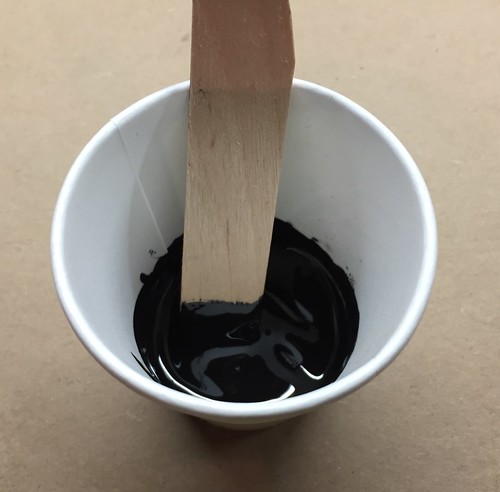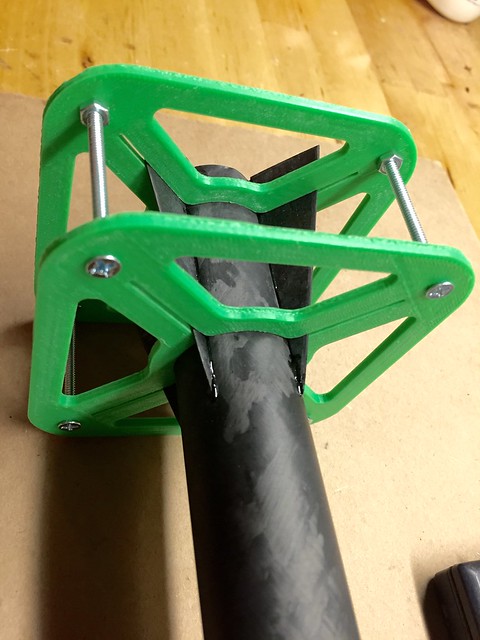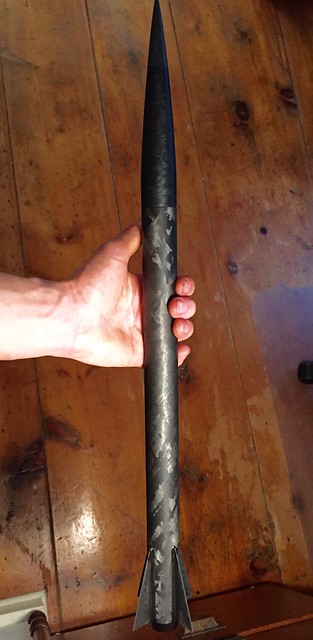RocketHunter
Well-Known Member
- Joined
- Jun 15, 2013
- Messages
- 390
- Reaction score
- 3
For the past few MD builds I've done, I've focused on shaving weight for maximum peak speed through using the flying-case design. Unfortunately, while they do go very fast and accelerate like nothing else, I haven't gotten close to the altitude I was expecting with them. Limited to URRG's 18K waiver, getting the highest possible altitude wasn't my goal, as even a 38mm MD can break 18-20k if designed right.
When RW put the 29mm Mongoose with a filament wound 2-piece nosecone, I new it was time to try to make an ultra-performance 29mm MD. Another nice aspect I realized was that, even optimized to perfection, a 29mm motor will assuredly never break an 18k waiver. Thus, for this build I have decided to forgo my usual flying-case design and go for as efficient and aerodynamic as possible, and for optimum weight rather than as light as possible.

Simulation says mach 2 and 16,000' with a CTI 6GXL I243-WH. I expect to fully get that speed, but my realistic hope for altitude is to top 14k. Maximum altitude means minimum volume, and an optimal weight of around ~7 oz. To achieve this, I pack a lot of stuff into a tiny area. The one-piece airframe is only 15.5" long, and houses a ~14.4'' motor casing. A 2.5'' coupler is glued into the top of this airframe, and acts as both the nose cone coupler, electronics/tracking bay, and thrust ring for the motor (since the CTI 29mm tail cone closure does not have a thrust ring). The fins are 0.05" thick 7-layer CF plate quickly made with Aeropoxy, and an antique cast-iron book press, with surprisingly good results - I used 19.8g of fabric and the finished plate only weighed 30.3g - giving me a nice ratio of 35% epoxy by weight.

I went with four fins for this design as I like the look and feel they are more dynamically stable (also, if one shortens the fin span when going from 4 to 3 fins to equalize stability between the two, it seem like 4 fins are no less efficient than 3). Also, it means less span as less chance for flutter - finsim puts flutter for these tiny things at over M3, so I should be quite safe. The nosecone will house 10' of 400 lb kevlar, and an 8'' or 12'' chute - deployed by altimeter at apogee. The coupler is 2.5'' long, and uses an ABS 3-D printed mount to hold a Perfectflight Stratologger CF, BRB beacon, 1s Lipo, screw switch, and integrated charge well. Took a bit of shaving to get it to fit, but its perfect now!


The CTI tail-cone closure is cool, but interestingly is flush with no thrust ring. To smooth the transition, I beveled the CF tube to match the taper in the closure.

The FWFG nose cone had a lot of extra epoxy in it, so I carefully drilled it out to open up some precious space. It will be filled with some metal noseweight, either BB's or maybe something a bit more efficient. If anyone has a nice method for making dense and compact noseweight I'd love to hear it!


Since I'm only using a small section of the Mongoose airframe and coupler, I have lots of leftover parts:

Depending on how long this build takes, I'm strongly considering building a nearly identical, 3-finned version but using the flying case format, and then fly them both on the same day and same motor to get a nice comparison in the performance of the two design philosophies.
While I'm posting pictures, I thought I might add a picture of my last, much less optimized 24mm MD "Pink Panther Mini", which should be a lot of fun on CTI 24mm G's - motor eject with an eggfinder in the payload.

Tomorrow I will be beveling the fins, lightening and gluing in the coupler tube, and maybe even tacking the fins! Any comments/ideas/suggestions welcome! :smile:
View attachment 29mm_MD.ork
When RW put the 29mm Mongoose with a filament wound 2-piece nosecone, I new it was time to try to make an ultra-performance 29mm MD. Another nice aspect I realized was that, even optimized to perfection, a 29mm motor will assuredly never break an 18k waiver. Thus, for this build I have decided to forgo my usual flying-case design and go for as efficient and aerodynamic as possible, and for optimum weight rather than as light as possible.

Simulation says mach 2 and 16,000' with a CTI 6GXL I243-WH. I expect to fully get that speed, but my realistic hope for altitude is to top 14k. Maximum altitude means minimum volume, and an optimal weight of around ~7 oz. To achieve this, I pack a lot of stuff into a tiny area. The one-piece airframe is only 15.5" long, and houses a ~14.4'' motor casing. A 2.5'' coupler is glued into the top of this airframe, and acts as both the nose cone coupler, electronics/tracking bay, and thrust ring for the motor (since the CTI 29mm tail cone closure does not have a thrust ring). The fins are 0.05" thick 7-layer CF plate quickly made with Aeropoxy, and an antique cast-iron book press, with surprisingly good results - I used 19.8g of fabric and the finished plate only weighed 30.3g - giving me a nice ratio of 35% epoxy by weight.

I went with four fins for this design as I like the look and feel they are more dynamically stable (also, if one shortens the fin span when going from 4 to 3 fins to equalize stability between the two, it seem like 4 fins are no less efficient than 3). Also, it means less span as less chance for flutter - finsim puts flutter for these tiny things at over M3, so I should be quite safe. The nosecone will house 10' of 400 lb kevlar, and an 8'' or 12'' chute - deployed by altimeter at apogee. The coupler is 2.5'' long, and uses an ABS 3-D printed mount to hold a Perfectflight Stratologger CF, BRB beacon, 1s Lipo, screw switch, and integrated charge well. Took a bit of shaving to get it to fit, but its perfect now!


The CTI tail-cone closure is cool, but interestingly is flush with no thrust ring. To smooth the transition, I beveled the CF tube to match the taper in the closure.

The FWFG nose cone had a lot of extra epoxy in it, so I carefully drilled it out to open up some precious space. It will be filled with some metal noseweight, either BB's or maybe something a bit more efficient. If anyone has a nice method for making dense and compact noseweight I'd love to hear it!


Since I'm only using a small section of the Mongoose airframe and coupler, I have lots of leftover parts:

Depending on how long this build takes, I'm strongly considering building a nearly identical, 3-finned version but using the flying case format, and then fly them both on the same day and same motor to get a nice comparison in the performance of the two design philosophies.
While I'm posting pictures, I thought I might add a picture of my last, much less optimized 24mm MD "Pink Panther Mini", which should be a lot of fun on CTI 24mm G's - motor eject with an eggfinder in the payload.

Tomorrow I will be beveling the fins, lightening and gluing in the coupler tube, and maybe even tacking the fins! Any comments/ideas/suggestions welcome! :smile:
View attachment 29mm_MD.ork
Last edited:


























